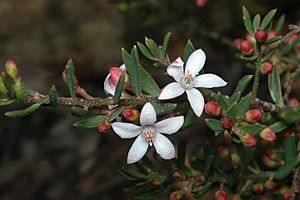Philotheca scabra facts for kids
Quick facts for kids Philotheca scabra |
|
|---|---|
 |
|
| Subspecies latifolia in the ANBG | |
| Scientific classification | |
| Genus: |
Philotheca
|
| Species: |
scabra
|
| Synonyms | |
|
|
Philotheca scabra is a type of flowering plant that belongs to the Rutaceae family. This family also includes citrus fruits like oranges and lemons! This plant is special because it only grows naturally in New South Wales, Australia.
It's a small bush with leaves that can look a bit different depending on its type. It grows pretty white or pink flowers, usually one at a time, at the tips of its branches.
What Philotheca scabra Looks Like
Philotheca scabra is a small bush that usually grows up to about 0.6 meters (or 2 feet) tall. Its stems can feel a bit rough or bristly.
Its leaves are directly attached to the stem, meaning they don't have a small stalk. They are about 10 to 15 millimeters long. Some leaves are shaped like a cylinder and folded in half lengthwise. Other leaves are narrow and oval-shaped, with a slight curve on the underside.
The flowers grow one by one at the very ends of the branches. Each flower sits on a tiny stalk, about 0.5 to 2 millimeters long. Below the flower, there's an even smaller stalk, 2 to 5 millimeters long, with two pairs of tiny leaf-like parts called bracteoles at its base.
Each flower has five thick, half-circle shaped sepals, which are like small leaves that protect the bud. These are about 1 millimeter long. There are also five oval-shaped petals that are white or pink and about 7 to 8 millimeters long. Inside the flower, you'll find ten stamens, which are the parts that produce pollen.
This plant usually blooms in the spring. After the flowers, it produces a fruit that is about 7 millimeters long and has a small beak-like tip, about 3 millimeters long.
How Philotheca scabra Got Its Name
This plant was first officially described in 1844 by a person named Joseph Paxton. He gave it the name Eriostemon scaber. He wrote about it in a magazine called Paxton's Magazine of Botany. He described it from a plant he saw in a nursery in England, which had come from a garden in Vienna, Austria.
Later, in 1970, a scientist named Paul G. Wilson studied Eriostemon scaber more closely. He realized there were two slightly different types, which he called subspecies. These were:
- Eriostemon scaber subsp. latifolia: This type has stems and leaves that are a bit warty and have small glands. Its leaves are about 12 millimeters long and 3 millimeters wide.
- Eriostemon scaber subsp. scaber: This type has smoother stems and leaves that are more cylindrical.
Then, in 1998, Paul G. Wilson changed the main name of the plant to Philotheca scabra. He also updated the names of the subspecies to match the new main name. So, the two types became:
- Philotheca scabra subsp. latifolia
- Philotheca scabra subsp. scabra
These names are still used today by plant experts in Australia.
Where Philotheca scabra Lives
Philotheca scabra grows in areas with heathland and forests. You can find it along the coast and in the nearby mountain ranges of New South Wales. It grows in the region between the city of Sydney and the areas around Nerriga and Nowra.
The subspecies scaber is found more in the northern parts of where the plant grows. The subspecies latifolius is found closer to Nerriga and Nowra.

